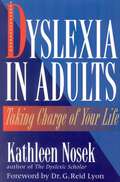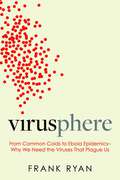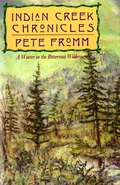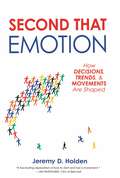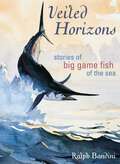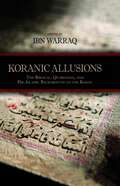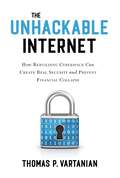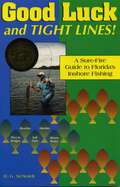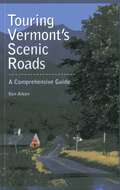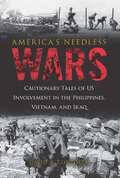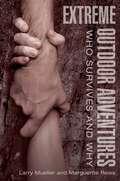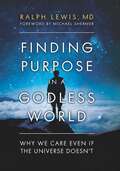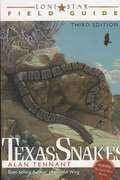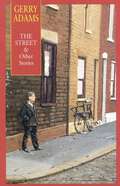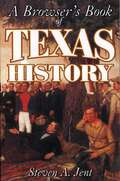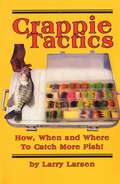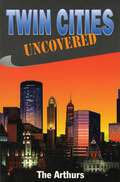- Table View
- List View
Dyslexia in Adults: Taking Charge of Your Life
by Kathleen NosekAuthor Kathleen Nosek offers dyslexic adults a unique approach that gets to the heart of the biggest problem they face—the shame and battered self-esteem resulting from decades of struggling with this frustrating and often misunderstood learning disability.
Tea at Miss Jean's
by Molly PearceAt each change of season, an elderly woman invites the neighborhood children to tea.Ages 8 and up
Virusphere: From Common Colds to Ebola Epidemics—Why We Need the Viruses That Plague Us
by Frank RyanA fascinating and long overdue examination of viruses - from what they are and what they do, to the vital role they have played in human history.What are viruses? Do they rely on genes, like all other forms of life? Do they follow the same patterns of evolution as plants and animals?Dr. Frank Ryan answers these questions and many more in a sweeping tour of illnesses caused by viruses. He examines the common cold, measles, chicken pox, herpes, mumps, and rubella, as well as less familiar maladies, such as rabies, "breakbone fever," hemorrhagic fevers like Ebola, and virus-induced cancers. Along the way, readers will learn about the behaviors of viruses and what drives them to infect a human host. Ryan explains the role of viruses in the evolution of life, revealing how viruses have changed us at the most intimate level, helping to make us quintessentially human.
Indian Creek Chronicles: A Winter in the Bitterroot Wilderness
by Pete Fromm"The wardens climbed into their truck, ready to leave. 'You'll need about seven cords of firewood. Concentrate on that. You'll have to get it all in before the snow grounds your truck.'""Though I didn't want to ask, it seemed important. 'What's a cord?'"So begins Pete Fromm's seven winter months alone in a tent in the Selway-Bitterroot Wilderness guarding salmon eggs. After blundering into this forbidding errand as a college lark, Fromm gradually come face to face with the blunt realities of life as a contemporary mountain man. Brutal cold, isolation, and fearful risks balance against the satisfaction of living a unique existence in modern America.This award-winning narrative is a gripping story of adventure, a rousing tale of self-sufficiency, and modern-day Walden. From either perspective, Fromm lives up to his reputation as one of the West's strongest new voices.
Second That Emotion: How Decisions, Trends, & Movements Are Shaped
by Jeremy D. HoldenAn advertising and communications expert traces the fascinating process whereby a passion for an idea, a politician, a celebrity, or a brand gives rise to a set of illogical beliefs that becomes the basis for a powerful movement. Conventional wisdom has it that spin doctors and Madison Avenue are responsible for manipulating our thoughts, causing us to endorse ideas or buy products that we would otherwise reject outright. Holden shows that while advertising and propaganda can provide a spark and social media provides the kindling, individuals create consumer, political, and cultural trends based, more often than not, on thinking that they know logically to be flawed. For businesspeople who want to see their company or brand break through, this book is both essential and entertaining reading. For the rest of us, the author provides a window into our decision-making processes, and how emotion-based illogical leaps drive our support for movements, whether they are political, commercial, or related to popular culture.
Tale of Three Tractors
by Molly PearceThree tractors competing at a county fair discover that each of them has its own special strengths and does what it does best.
Texas Boys In Gray
by Evault BoswellBased on a 1912 publication about Texans who fought for the South in the Civil War, Texas Boys in Gray presents a collection of fascinating remembrances of those who were there. Sometimes humorous and sometimes heartbreaking, the experiences of these men are documented as a tribute to Texas war veterans. Texas Boys in Gray captures, in their own words, the patriotism, the fear, the confusion, the bravery, the terrible wounds, the desperate hunger, the camaraderie, the horrible prison conditions, and the joyful reunions that were all part of that historical time.
Veiled Horizons: Stories of Big Game Fish of the Sea
by Ralph BandiniFirst published in 1939 by The Derrydale Press, Veiled Horizons offers a collection of anecdotes of fishing for the giants of the sea as well as "fish tales" many would find difficult to swallow. Writing in the same style as Zane Grey's fishing stories, Ralph Bandini enthralls his readers with breath taking descriptions, narrow escapes and of course, the one that got away.
Tale of Two Cities: The 2004 Yankees-Red Sox Rivalry And The War For The Pennant
by Tony Massarotti John HarperWhen the Boston Red Sox faced the New York Yankees in the historic 2003 American League Championship Series, the meeting seemed to serve as the climax to perhaps the greatest rivalry in professional sports. Yet, following New York&’s comeback victory in scintillating Game 7, both the Red Sox and Yankees entered the off-season without a world title--and with renewed conviction to finish the job in 2004.In A Tale of Two Cities, respected baseball writers John Harper (New York Daily News) and Tony Massarotti (Boston Herald) chronicle the Yankees and Red Sox in parallel story lines through the summer of 2004. The authors take you behind the scenes with the teams, cities, and media during one of the most intense baseball seasons in history.
Koranic Allusions: The Biblical, Qumranian, and Pre-Islamic Background to the Koran
by Ibn WarraqFor anyone with an interest in the early history of Islam, this erudite anthology will prove to be informative and enlightening. Scholars have long known that the text of the Koran shows evidence of many influences from religious sources outside Islam. For example, stories in the Koran about Abraham, Moses, Jesus, and other characters from the Bible obviously come from the Jewish Torah and the Christian Gospels. But there is also evidence of borrowing in the Koran from more obscure literature. In this anthology, the acclaimed critic of Islam Ibn Warraq has assembled scholarly articles that delve into these unusual, little-known sources. The contributors examine the connections between pre-Islamic poetry and the text of the Koran; and they explore similarities between various Muslim doctrines and ideas found in the writings of the Ebionites, a Jewish Christian sect that existed from the second to the fourth centuries. Also considered is the influence of Coptic Christian literature on the writing of the traditional biography of Muhammad.
The Unhackable Internet: How Rebuilding Cyberspace Can Create Real Security and Prevent Financial Collapse
by Thomas P. VartanianLike most aspects of modern existence, more and more of our financial lives have migrated to the digital realm. With the benefits of ease that our Internet allows us, that transition also raises numerous – and dangerous – threats to national security, our money, and the systems we use to store and transfer it. In TheUnhackable Internet, financial services and technology expert Thomas P. Vartanian exposes the vulnerabilities of the many networks that we rely on today as well as the threats facing the integrity of our national security and financial services sector. From cyberattacks by foreign adversaries like China and Russia, the explosion of cryptocurrency, the advancement of ransomware, phishing, surveillance apps, spying software, and logic bombs, along with the increasing savvy and daring shown by Internet hackers, the next financial panic is likely to be delivered to us through use or abuse of technology. The Unhackable Internet describes how society can remake an Internet that was never conceived as a secure environment and badly tainted by the original sin of substandard coding. Vartanian argues for increasing the use of private and offline network infrastructures, controlling the ownership of Internet infrastructure, and imposing enhanced authentication, governance, and enforcement standards. This online universe would look more like our analog lives, authenticating all digital traffic to a real person and removing any virtual traveler that violated the new rules of the road. The Unhackable Internet poses a challenge to America: take the lead and create a coalition of democratic nations to implement financial cyber strategies or be left with no counterweight short of military power to respond to those who weaponize technology. This comprehensive and compelling book makes it clear that nothing less than the control of global economies is up for grabs, and that how we use technology is our choice.
Good Luck and Tight Lines: A Sure-Fire Guide to Florida's Inshore Fishing
by R. G. SchmidtPacked with the wheres, whys, and hows of fishing Florida's inshore water, vacationers, new residents, and even longtime anglers will discover what to look for, which lures to use, and where to go.
Touring Vermont's Scenic Roads: A Comprehensive Guide
by Kenneth AikenVermont is quintessential New England and a wonderful state to explore, offering grand vistas, lovely farms and villages, historic sites, and rolling mountains. In addition you'll encounter minimal traffic, plenty of scenic turnoffs, and absolutely no billboards.Here a native Vermonter guides us through the entire state, from windswept peaks to lush farmlands, from magnificent Lake Champlain to the Northeast Kingdom. Fascinating histories and anecdotes accompany the precise road directions, giving us a sense of the true character of Vermont.
America's Needless Wars: Cautionary Tales of US Involvement in the Philippines, Vietnam, and Iraq
by David R. ContostaThis eye-opening book takes a unique approach to the history of U.S. foreign policy by examining three unrelated conflicts, all of which ended tragically and resulted in the deaths of millions on both sides. By analyzing what went wrong in each case, the author uncovers a pattern of errors that should serve as a precaution for future decision makers contemplating a conflict abroad. Why did President McKinley oppose Filipino independence forces if his motivation was truly to help Filipinos overthrow Spanish domination? Why did several U.S. presidents ignore the failures of the French in Vietnam and reject peace overtures from popular revolutionary leader Ho Chi Minh to bring the conflict to an early end? And how could American leaders have been so wrong about Saddam Hussein's alleged weapons of mass destruction and then let Iraq devolve into chaos after overthrowing the dictator? Historian David R. Contosta has sifted through official hearings, media investigations, public documents, memoirs of those for and against the conflicts, and numerous histories to uncover the answers to these questions. The common thread that links these wars from different centuries is that political leaders all too often have acted out of ignorance, arrogance, fear, and partisan gamesmanship. These lapses were compounded by the failure of the media to inform the public accurately and dispassionately. The sad result is that America has paid a high price in lost lives and tarnished national reputation. As the author notes in conclusion, if American exceptionalism is to have any meaning, then we must honestly appraise our past foreign-policy blunders to ensure wiser political action in the future.
What I Saw in Grand Canyon: A Kid's Guide to the National Park
by Julie Gillum LueExplore Grand Canyon National Park—its geology, wildlife, history and more—and keep track of the things you see in the park. See how much you can check off—and have fun looking and learning. Then take this book home to share your Grand Canyon experience with family, friends, and classmates.This guide is packed with:color photos to help you identifylively descriptionsfun "guess what" factoidsprecise "where to see it" directions
Extreme Outdoor Adventures: Who Survives And Why
by Larry Mueller Marguerite ReissIncredible but True Stories of Confronting Death and Emerging VictoriousThe rock climber who cut off his own arm with a penknife. The hiker who fought off a mountain lion. Passengers who survive the crash of a bush plane in Alaska. We read headlines we sometimes find hard to believe, yet there are on record dozens of such events. Here is a collection of tales from everyday people who faced terrible odds, accidents, extreme weather, wild animals, or severe injury, many describing how they entered another state of consciousness – an &“adrenaline high&” – to get away alive. Forget reality TV – this is real entertainment for the survival-story fanatic.
Bruin 100: The Greatest Games in the History of UCLA Basketball
by Scott Howard-CooperUCLA basketball is history as much as tradition. From the early days when the lack of reasonable travel options forced the Bruins to play local high school teams, to the World War II years against the studio teams from Hollywood, to the almost surreal success during the 1960s and 70s, to beyond.Jackie Robinson played basketball at UCLA. So did Rafer Johnson. They were part of the era when the Bruins often struggled for wins, strange as that would come to sound for a program that would one day have 88 of them in a row. Lew Alcindor came from the East to dominate, Bill Walton from the West to maintain the greatness, John Wooden from the heartland of Indiana to lead them both, and to lead them all.The Bruin 100 recounts—in order of importance to the sport and the programs—how Wooden nearly didn't come to UCLA and the moment when Alcindor was glad he did. It chronicles the guard who later won the Nobel Peace Prize, the forward who helped save a life in the afternoon and a team later that night, the center who wasn't a superstar but played like it to keep the dynasty alive.It brings back the people and the moments, the most storied games in the most successful of programs. The national championships, the loss to Houston in what has been called the Game of the Century. The record winning streak, the loss to North Carolina State in the Final Four that still pains. The coast-to-coast run by Tyus Edney against Missouri, the even-more-improbable run by Larry Brown's underdog team to reach the title game.Relive the tradition, some parts of which are not even detailed in the record books, through photos and anecdotes and the foreward by Kareem Abdul-Jabbar. Or live it for the first time.
Finding Purpose in a Godless World: Why We Care Even If the Universe Doesn't
by Ralph LewisA psychiatrist presents a compelling argument for how human purpose and caring emerged in a spontaneous and unguided universe. Can there be purpose without God? This book is about how human purpose and caring, like consciousness and absolutely everything else in existence, could plausibly have emerged and evolved unguided, bottom-up, in a spontaneous universe. A random world--which according to all the scientific evidence and despite our intuitions is the actual world we live in--is too often misconstrued as nihilistic, demotivating, or devoid of morality and meaning. Drawing on years of wide-ranging, intensive clinical experience as a psychiatrist, and his own family experience with cancer, Dr. Lewis helps readers understand how people cope with random adversity without relying on supernatural belief. In fact, as he explains, although coming to terms with randomness is often frightening, it can be liberating and empowering too. Written for those who desire a scientifically sound yet humanistic view of the world, Lewis's book examines science's inroads into the big questions that occupy religion and philosophy. He shows how our sense of purpose and meaning is entangled with mistaken intuitions that events in our lives happen for some intended cosmic reason and that the universe itself has inherent purpose. Dispelling this illusion, and integrating the findings of numerous scientific fields, he shows how not only the universe, life, and consciousness but also purpose, morality, and meaning could, in fact, have emerged and evolved spontaneously and unguided. There is persuasive evidence that these qualities evolved naturally and without mystery, biologically and culturally, in humans as conscious, goal-directed social animals. While acknowledging the social and psychological value of progressive forms of religion, the author respectfully critiques even the most sophisticated theistic arguments for a purposeful universe. Instead, he offers an evidence-based, realistic yet optimistic and empathetic perspective. This book will help people to see the scientific worldview of an unguided, spontaneous universe as awe-inspiring and foundational to building a more compassionate society.
Sharks Get Cancer, Mole Rats Don't: How Animals Could Hold the Key to Unlocking Cancer Immunity in Humans
by James S. Welsh, MDThis fresh and fascinating exploration of new directions in cancer research focuses on the important role of the immune system in combatting this dread disease. Integrating clues from the animal kingdom, the veterinary clinic, extraordinary human cases, and even embryology, the author-a cancer physician, biologist, and physicist-creates a novel and compelling account of tumor immunology and the promises of immunotherapy. As the author explains, animals offer us many tantalizing clues about the nature of cancer in humans. Tasmanian devils are on the verge of extinction due to a virulent form of contagious cancer; soft-shelled clams on the East coast of North America are vanishing due to another epidemic of contagious cancer; dogs also contract a contagious cancer but they spontaneously overcome it; and a type of mouse and the homely mole rat are not susceptible to the disease at all. In humans, there are rare instances of spontaneous cures of advanced cancers induced by radiation. An uncommon form of dwarfism called Laron syndrome confers total cancer immunity on the people who inherit the condition. And recent research suggests that cancer has stolen the secret that shields the embryo against hostile attacks from the mother's immune system. The author makes a convincing case that what all of these diverse examples have in common is the immune system and its ability or inability to respond to malignancies. He concludes with a review of the exciting research on the human immune system and the development of new treatments that are inducing the immune system to combat and conquer even the deadliest cancers.
Moose on the Loose
by John Hassett Ann HassettIn Moose on the Loose by Ann and John Hassett, follow the adventures of Max the moose. Max is a curious moose - so curious that he travels to a nearby city to see how humans live. His adventures culminate in an exciting helicopter rescue and convinces him that curiosity is almost as bad for moose as it is for cats!
Lone Star Field Guide to Texas Snakes
by Alan TennantThe State of Texas not only boasts the largest snakes in North America, but also the largest number of species—105. This guide describes in detail each and every one of them, from the benign Texas long-nosed snake, to the venomous Western Cottonmouth. Facts on the biology and behavior are given, plus the latest findings on abundance, reproduction, prey, sizes, and habitat. In addition, introductory chapters describe the physiology and diet of snakes, and an all-important section on "Venom and Evenomation" debunks the many myths surrounding what to do when bit by a venomous snake. 128 color plates of species and subspecies aid in identification.
The Street & Other Stories
by Gerry AdamsOne of the world's best-known political figures shares stories that reveal the humanity and indomitable spirit of ordinary people caught up in extraordinary events. The moving accounts of the fictional characters in these eighteen short stories are set against the political turmoil of Gerry Adams' native Belfast.
Browser's Book of Texas History
by Steven JentIf you love history and want to amaze your family and colleagues with your prodigious knowledge of Lone Star lore, this book is just what you need.A Browser's Book of Texas History is a day-by-day collection of more than 500 incident-some famous, some obscure-that have made Texas the most remarkable state in the Union. Even if you're a dedicated historian or an old-time Texan, you're likely to find something surprising, amusing, thought provoking, or just plain odd.With this book you can start every day of the year with a concise entry from the chronicles of this unique state, which just seems to naturally breed colorful people and bigger-than-life events.
Crappie Tactics
by Larry LarsenThis book contains detailed information on how, when and where to catch more crappie year round. Divided into three comprehensive sections, Larsen discusses the basics for fun, places for action, and advanced tactics.
Twin Cities Uncovered
by The ArthursTwin Cities Uncovered takes you from restored barns to fragrant apple orchards to the "Mighty Mississippi Bicycle Adventure" that runs from Minneapolis to cities far across America. Ride the antique, hand-carved carousel at the Minnesota State Fair, or stroll the "Mississippi Mile" along the cobblestone Main Street to a row of quaint shops, charming restaurants, and coffee houses on the water's edge. Recall the romance of Longfellow's "Hiawatha" by the showers of Minnehaha Falls, or step back in time and share the lifestyle of immigrant settlers at a living museum.
